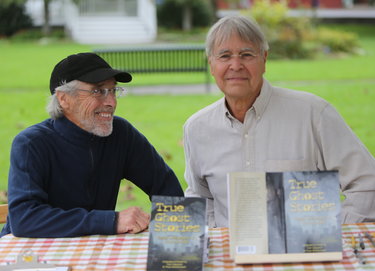‘True Ghost Stories’ raises profound questions on reality, life and death
ALTAMONT — Two creative men from Altamont have gathered ghost stories from village residents and surrounding areas into a book. Neither is a stranger to imagination and yet they have labeled these stories as true.
Tom Capuano, a retired professor, once wrote a book-length narrative poem on the founding of Altamont, grounded in history but with imaginative creation of characters. He raises sheep now in an 18th-Century barn on land that both figure prominently in some of the ghost stories.
Thom Breitenbach, an artist who lives in a castle he built on the hillside above the village, wrote and produced a musical about Hieronymus Bosch, a 15th-Century Dutch artist who, like Breitenbach, creates imaginative creatures. In Breitenbach’s musical, those creatures come alive.
So where does each draw the line between imagination and reality?
Their collaborative work, “True Ghost Stories From Altamont & Surrounds,” came about because Capuano, researching the history of local houses, asked Breitenbach about a neighbor’s home. Breitenbach recalled stories a woman in her eighties had told when his father bought their property in 1962, including a story about a house up the hill said to be haunted.
Breitenbach suggested they work on a book and the pair started collecting stories from friends and neighbors. At the annual Altamont village-wide garage sale last spring, Breitenbach approached people with historic homes and was himself approached with more tales when people saw the artwork he had done for the cover of the book.
The pair set up an email address, altamontghosts@gmail.com, and publicized their book in The Altamont Enterprise.
They were surprised with the number of stories, over 70, that people wanted to share. Some contributors wrote their own vivid narratives while Breitenbach and Capuano helped those who had tales to tell but hesitated with writing.
They will sign and sell their book at an event at the Altamont Free Library at 1 p.m. on Oct. 16 and again at 7 p.m. on Oct. 21 at the Berne Library. Books may also be purchased through Breitenbach’s website: tebreitenbach.com.
Both authors, in this week’s podcast at AltamontEnterprise.com/podcasts, thanked the many village and Helderberg residents who came forward with stories. “Sharing these experiences takes a lot of courage,” says Capuano.
“I was really shocked …,” says Breitenbach. “I had to rethink my ideas about what ghosts really are and what happens when we die.”
He believes the stories of hauntings — most of them by benevolent spirits — are true and cites how, in many stories in the book, more than one person saw “the exact same thing.”
“Ghosts are a real thing,” says Breitenbach.
He is not alone in his beliefs. About three in four Americans profess at least one paranormal belief, according to a 2005 Gallup poll, with 37 percent believing houses can be haunted.
Breitenbach references one of the stories in the book, by Mary Beth Nowak, who, for a college class, had to give a speech to convince her classmates of something.
Before she gave her speech — based on Altamont ghost stories collected by the postmaster’s wife — Nowak asked her classmates who believed in ghosts and maybe half raised their hands. After she told the stories, she wrote, “They all did!”
“I approach this project from the historical dimension,” says Capuano. He says the stories can tell readers about the myths, “the impressions we carry with us because we live in a certain place.”
Some stories in the book go back to the Revolutionary War; others speak of Native Americans who lived here before European settlers, while another references the French and Indian War, and still another references Ku Klux Klan lynchings.
Capuano is interested in the merging of history and myth. Some of the stories in the book, he said, “just dare you to deny the intrusion of supernatural phenomena.”
The stories made Breitenbach ponder: What does happen after death?
He speculates that maybe time doesn’t exist. “Maybe there’s a break in the continuum,” Breitenbach says.
“Humans long for this connection with a reality that’s beyond us,” says Capuano.
Imagining the people who once lived in the same spaces we now inhabit, he said, we wonder, “Could they be totally gone? … We don’t want to be gone.”
—Melissa Hale-Spencer



